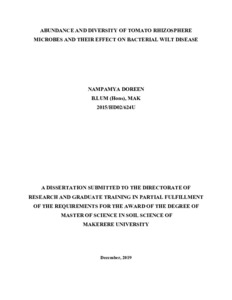| dc.contributor.author | Nampamya, D. |
| dc.date.accessioned | 2022-09-30T10:06:09Z |
| dc.date.available | 2022-09-30T10:06:09Z |
| dc.date.issued | 2019-12 |
| dc.identifier.citation | Nampamya, D. (2019). Abundance and diversity of tomato rhizosphere microbes and their effect on bacterial wilt disease. Kampala, Uganda: Makerere University, (77p.). |
| dc.identifier.uri | https://hdl.handle.net/20.500.12478/7828 |
| dc.description.abstract | The use of land for agricultural production is always accompanied with changes in microbial diversity and emergency of new pathogens. Microbial imbalances and unevenness have enhanced multiplication of pathogens and proliferation of many soil borne diseases, which are tedious to control. Biocontrols are promising and environmentally friendly agents against such diseases. However, microbiome composition and land use management have been mentioned as core factors in effectiveness of biocontrols. These factors are shaped by management and land use types. The focus of this research was to determine the diversity and abundance of microbes in the tomato rhizosphere and its effect on severity and control of bacterial wilt disease.
Tomatoes were grown in a screen house at Namulonge using unsterilized soils from cultivated, fallow and forest land use types. Four biocontrols were used namely; Bacillus subtilis, Bacillus amyloliquefaciens, Peanibacillus polymyxa and Stenotrophomonas rhizophila. A negative control and a positive control were included. Data were collected on plant growth and yield parameters, and bacterial wilt disease incidence. Rhizosphere microbiome data were obtained using amplicon sequencing. Results showed that B. subtilis and P. polymyxa increased plant height in all land use types. Biocontrols B. amyloliquefaciens and S.rhizophila produced most dry biomass in cultivated land use, B. amyloliquefaciens and P. polymyxa in fallow and P. polymyxa and B. subtilis in forest land use type. In cultivated land use, biocontrols B. amyloliquefaciens, B. subtilis and S. rhizophila reduced bacterial wilt incidence by 31 % and P. polymyxa by 28 %. Fallow land use type had the highest microbial diversity and forest land use had the highest microbial abundance. The major phyla were Proteobacteria, Actinobacteria and Acidobacteria in Forest, Fallow and cultivated land uses respectively. Bacillus and Paenibacillus bacteria were more abundant in cultivated while Stenotrophomonas bacteria were
more abundant in forest land use type. |
| dc.description.sponsorship | Austrian Developmental Agency |
| dc.format.extent | 77p. |
| dc.language.iso | en |
| dc.publisher | Makerere University |
| dc.subject | Biodiversity |
| dc.subject | Biological Control |
| dc.subject | Tomatoes |
| dc.subject | Agricultural Production |
| dc.subject | Pathogens |
| dc.subject | Soil |
| dc.subject | Stenotrophomonas |
| dc.subject | Rhizosphere |
| dc.subject | Land Use |
| dc.subject | Forests |
| dc.title | Abundance and diversity of tomato rhizosphere microbes and their effect on bacterial wilt disease |
| dc.type | Thesis |
| cg.contributor.affiliation | Makerere University |
| cg.contributor.affiliation | International Institute of Tropical Agriculture |
| cg.coverage.region | Africa |
| cg.coverage.region | East Africa |
| cg.coverage.country | Uganda |
| cg.identifier.bibtexciteid | NAMPAMYA:2019 |
| cg.authorship.types | CGIAR and developing country institute |
| cg.iitasubject | Agribusiness |
| cg.iitasubject | Agronomy |
| cg.iitasubject | Biodiversity |
| cg.iitasubject | Disease Control |
| cg.iitasubject | Pests of Plants |
| cg.iitasubject | Plant Diseases |
| cg.iitasubject | Plant Production |
| cg.notes | IITA supervisor: Dr. Danny Coyne |
| cg.publicationplace | Kampala, Uganda |
| cg.accessibilitystatus | Limited Access |
| cg.reviewstatus | Internal Review |
| cg.usagerightslicense | Copyrighted; all rights reserved |
| cg.targetaudience | Scientists |
| cg.futureupdate.required | No |
| cg.contributor.acknowledgements | I extend my sincere thanks to Austrian Developmental Agency (ADA) that funded the Healthy Vegetable Seedlings project at the International Institute of Tropical Agriculture, (IITA) and University of Technology, Graz, for which this study was part. I am tremendously grateful to my academic supervisors Dr. John Baptist Tumuhairwe and Prof. Herbert Talwana at Makerere University for their guidance from the time when the research was started up to the final stage. I also appreciate Dr. Danny Coyne, the project PI and Mr. James Kisaakye both at IITA for the guidance and support offered during the research period that gave me hope and courage to keep moving. I appreciate the staff at IITA Sendusu, Namulonge members both staff and casual laborers for the good environment and support rendered during this research. My sincere thanks are due to the team from the University of Technology, Graz led by Prof. Gabriel Berg for support rendered during laboratory activities and thesis compilation. I also acknowledge the efforts of my friends and classmates for the encouragement and advice that pushed me through trying moments during the period of study. May God bless you abundantly! For God and my country! |

